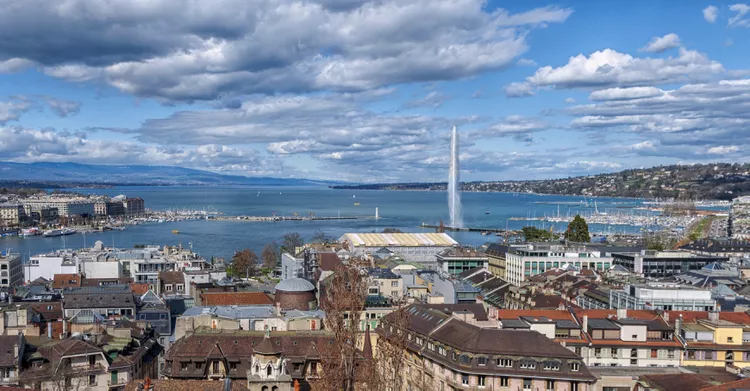Summary
Geneva lies between the Alps and the Jura mountains on the shore of Lake Geneva on the west side of Switzerland, bordering on France. Consequently, Geneva is the second largest city in Switzerland after Zürich.
Getting There
You can get to Geneva by air using the Geneva Cointrin International Airport. Because Geneva is located on the border with France, its main station, Cornavin Railway Station, is connected to both the Swiss railway network SBB-CFF-FFS and the French SNCF network, including TGV trains. Geneva is also accessible via the A1 toll road, linking it to the rest of Switzerland and France.
Airport Transportation into Geneva
Geneva International Airport is just three miles away from the city center. Moreover, the train service takes you to the city center in six minutes, with departures every 15 minutes, making it a convenient option. You can download maps and access plans from the airport website. Additionally, there are options for free transportation to your hotel via train.
Geneva’s Central Train Station – Gare de Cornavin
The Gare de Cornavin is centrally located, approximately 400 meters north of the lake. If you arrive on a SNCF (French) train, you will arrive at platforms 7 and 8, where you must pass through both French and Swiss customs and passport control before exiting the station.

Neighborhoods in Geneva to Visit
Carouge, situated 2km south of the city center, is often referred to as the “Greenwich Village of Geneva” due to its low-slung houses, artist studios, and cozy cafes. This area was developed in the late 1700s by Turinese architects envisioned by the king of Sardinia, Victor Amideus, as a trading rival to Geneva and a refuge for Catholics. Therefore, it’s worth dedicating half a day to explore this charming neighborhood. Geneva’s Rive Gauche area is known for shopping and banking, featuring a stunning view of Mont Blanc from the waterfront. In Old Town, you will discover the market (Place du Bourg-de-Four), picturesque cobbled streets, and austere grey-stone houses.
Weather and Climate
Geneva generally enjoys a pleasant climate during the summer months. If you visit in the fall, expect occasional rain. For detailed historical climate charts, you may refer to Geneva Travel Weather and Climate.
Tourist Offices & Maps
The main Tourist Office is located at 18 Rue du Mont-Blanc in the central post office (Open Mon-Sat 9am-6pm). A smaller office is situated at the Municipality of Geneva on the Pont de la Machine (Open Mon noon-6pm, Tues-Fri 9am-6pm, Sat 10am-5pm). Either tourist office can provide you with a free map as well as valuable information on what to see and where to stay.
You can download various city maps of Geneva in PDF format for printing from Geneva Tourism.
Places to Stay
For the top hotels in Geneva, numerous unique accommodations are available at various price points. If you prefer apartments or vacation houses, HomeAway offers vacation rentals worth considering.
Cuisine
Geneva is home to a variety of restaurants offering traditional Swiss cuisine alongside international favorites. You can expect to find typical cheese dishes like fondue and raclette, as well as lake fish dishes, smoked sausage, and an assortment of casseroles and stews.
Cafe du soleil (www.cafedusoleil.ch) is particularly renowned for its fondue.

Geneva Tourist Attractions
You will want to meander through Geneva’s old town (vielle ville) to gain insight into what life was like in the 18th century. While there, a visit to Saint-Pierre Cathedral, located at the top of the hill in the heart of Geneva’s old town, is a must. Here, you can embark on an underground journey through archaeological excavations, which reveal remains from the 3rd century BC through to the 12th-century construction of the current cathedral.
If your visit coincides with the beginning of August, don’t miss the Fêtes de Genève (Geneva Festival) on the waterfront. This vibrant event showcases “music of all kinds, love mobiles, techno floats on the lake, theater, fun fairs, street entertainers, stalls selling food from around the world, and a spectacular lakeside musical fireworks display.”
Geneva’s primary landmark, the Jet d’Eau, is not to be missed; it jettisons a stunning 140-meter-high column of water over Lake Geneva.
In addition to the Archaeological Site of Saint Peter’s Cathedral, here are some notable museums in Geneva:
- Art and History Museum – designed in the early 20th century, aiming to cover the entirety of western culture, from its origins to the present day.
- International Red Cross and Red Crescent Museum – the birthplace of the International Red Cross.
- Rath Museum – the first Swiss museum dedicated to the fine arts.
- Natural History Museum – the largest natural history museum in Switzerland.
- MAMCO – Museum of Modern and Contemporary Art, featuring modern installations, videos, paintings, photographs, and sculptures.
- Ariana Museum – the only museum in Switzerland dedicated entirely to kilncraft, ceramics, and glass.
- Conservatory and Botanical Gardens – showcasing a collection of 16,000 plant species from around the globe near the waterfront.
- Martin Bodmer Foundation – a private library containing 160,000 documents in 80 languages, including one of the few copies of the Gutenberg Bible.
- International Museum of the Reformation – tracing the history of the Reformation movement initiated by John Calvin in Geneva.





